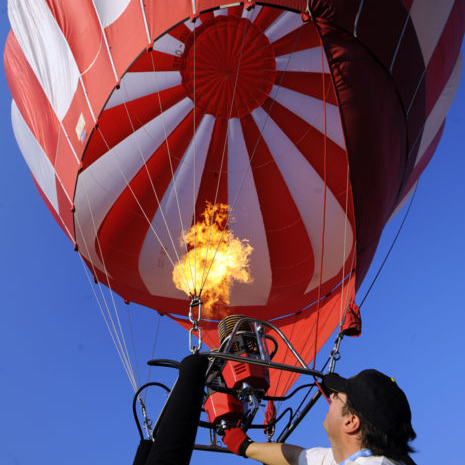Master The Art Of Steering A Hot Air Balloon

Steering a hot air balloon is an exhilarating experience that requires skill, knowledge, and a deep understanding of aerodynamics. From the basics of controlling altitude to mastering wind patterns, we will cover everything you need to know to become a confident hot air balloon pilot.
The Fascinating History of Hot Air Balloons
Before we delve into the mechanics of steering a hot air balloon, let’s take a moment to appreciate the rich history of these majestic flying vessels. In 1783, the Montgolfier brothers launched the first untethered hot air balloon flight in Annonay, France, marking the birth of human flight.
Understanding the Basics: How Hot Air Balloons Work
To steer a hot air balloon effectively, it’s crucial to grasp the fundamental principles that govern its flight. A hot air balloon operates on the principle of buoyancy, where the warm air inside the envelope is lighter than the cooler air outside. This creates an upward force, lifting the balloon and its passengers into the air.
The burner, fueled by propane, heats the air inside the balloon, allowing it to ascend. To descend, the pilot releases hot air through the parachute valve, causing the balloon to gradually lower.
Equipment and Safety Precautions
Before embarking on a hot air balloon adventure, it’s essential to be familiar with the equipment used and the safety precautions that must be taken. Hot air balloons consist of various components, including the envelope, burner, basket, and fuel system. Each part plays a crucial role in ensuring a safe and enjoyable flight.
Important Safety Tips:
- Always perform a thorough pre-flight inspection of the balloon and equipment;
- Check weather conditions and forecasts to avoid adverse flying conditions;
- Ensure all passengers are briefed on safety procedures before take-off;
- Maintain a safe distance from power lines and other obstacles during flight;
- Carry emergency supplies and communication devices in case of unexpected situations.
Steering Techniques: Using the Wind to Your Advantage
Steering a hot air balloon primarily involves using the wind’s varying directions and speeds at different altitudes. Balloon pilots make use of different wind layers to change their course and reach their desired destination. By ascending or descending, they can access various wind currents, often referred to as the wind gradient.
Wind Gradient Technique: Ascending to a higher altitude can provide access to faster wind currents, while descending may lead to slower winds. Pilots can utilize these variations to navigate horizontally and change directions.
Tethering: For beginners or demonstration purposes, tethering is a useful technique. Tethered balloons are tied to the ground with ropes, allowing limited movement and providing an opportunity to practice basic steering skills.

Mastering the Art of Landing
As any experienced hot air balloon pilot knows, a successful landing requires finesse and precision. Landing a hot air balloon involves finding a suitable landing spot, adjusting the descent rate, and ensuring a gentle touchdown.
Step-by-step Landing Procedure:
- Selecting the Landing Spot: Pilots look for large open areas, free from obstacles, and away from populated zones. Ideally, the chosen spot should have a minimal risk of strong wind gusts;
- Adjusting Descent Rate: By releasing hot air and descending at a controlled rate, pilots can avoid abrupt landings and ensure a smooth touch-down;
- Coordinating with the Ground Crew: Effective communication between the pilot and the ground crew is essential for a safe landing. The ground crew assists in securing the balloon after landing.

Adapting to Weather Conditions
Weather plays a significant role in hot air ballooning, and pilots must be skilled at interpreting weather forecasts and making informed decisions based on current conditions. Wind speed, wind direction, temperature, and atmospheric stability all impact the flight experience.
Rain and Storms: Hot air ballooning during rain or storms is dangerous and should be strictly avoided. Unstable atmospheric conditions can cause sudden changes in wind direction and intensity, posing risks to the flight.
Early Morning and Late Evening Flights: Hot air balloons are often flown during these times as the air is cooler and more stable, leading to smoother flights.
Troubleshooting and Emergency Procedures
Despite thorough planning and preparation, unforeseen circumstances may arise during a hot air balloon flight. Pilots must be equipped to handle emergencies and troubleshoot technical issues.
Common Emergency Scenarios and Actions:
- Rapid Descent: If the balloon descends rapidly due to excessive heat loss, the pilot should release some hot air to regain altitude;
- Lost Landing Site: In case the pilot cannot reach the initially planned landing site, they must identify an alternative safe location and communicate with the ground crew;
- Contacting Emergency Services: In serious emergencies, such as injury or severe weather changes, the pilot should contact emergency services and follow appropriate protocols.
Conclusion
Mastering the art of steering a hot air balloon requires a combination of knowledge, skill, and adaptability. Understanding the principles of flight, using wind to navigate, adhering to safety precautions, and being aware of weather conditions are all crucial elements in becoming a skilled hot air balloon pilot. So, prepare for an extraordinary adventure and embark on a journey that will undoubtedly leave you with unforgettable memories.